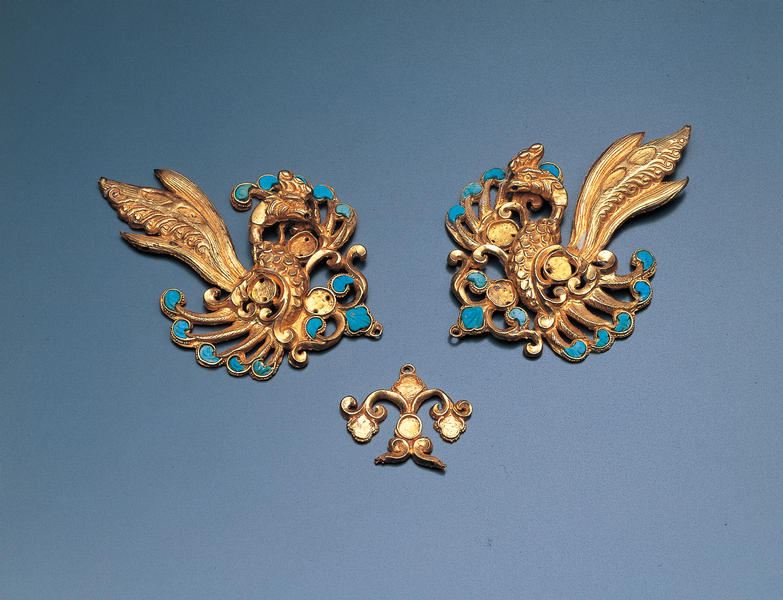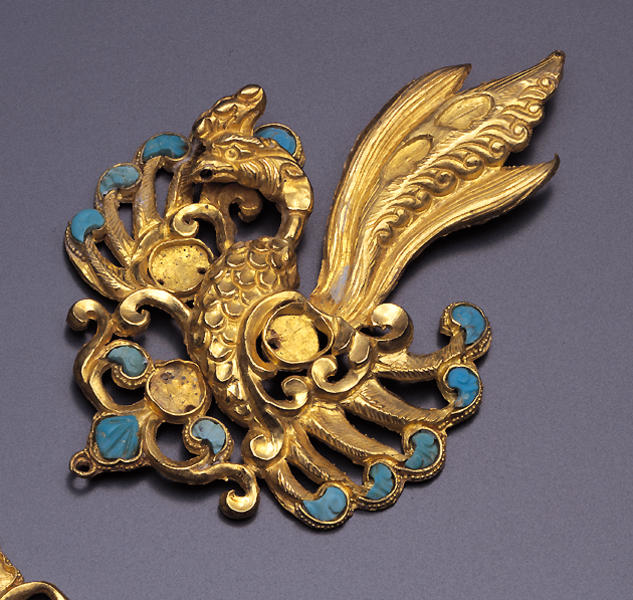鳳凰形髪飾
- 中国
- 中国・唐時代
- 7-9世紀
- 金、トルコ石
- W-6
大きい方の2点の飾りは金の平らな板から鍛造および打ち出しによって鳳凰の形に作り上げられている。2羽の鳥の胸の下方には,手の込んだ打ち出しと彫り込みによって作られた植物のモティーフがある。この植物モティーフの数か所には,2羽の鳥の両側の羽と同じくトルコ石が埋め込まれている。2羽の金の鳥に取り付けられた三つの円形の窪みにも当初は宝石が象嵌されていた。5飾板にはいずれも中央下方の象嵌の背面に「義」の文字が刻まれている。おのおのの飾板はそこに穿たれた一つの小さな穴によって組み合わされたヘアピンに取り付けられた。
Catalogue Entry
The lure of gold was evident even in death, for a number of Chinese tombs were supplied with shimmering personal adornment items shaped out of this precious material. Although the Chinese initially preferred hairpins fashioned out of bone or jade, by the Bronze Age the custom of creating hairpins out of gold was introduced into China by people living beyond its northern borders.1
During the early Western Zhou period (1027-771 B.C.), turquoise beads had been added to hair ornaments, and by the late Eastern Zhou period (475-221 B.C.) a more complex hair decoration, the headdress, was created as well.2 During the Western Han period (206 B.C.-8 A.D.) a unique hair accessory, the buyao, became popular.
The buyao hair accessory features valuable gemstones in addition to precious-metal bird and floral forms, all of which are suspended from a elaborate hairpin structure. Such pieces were designed to sway as their wearer walked. One of the earliest known visual images of a buyao hair accessory can be found on a funeral banner unearthed from the Mawangdui tombs in Hunan province that features the deceased, Lady Dai, wearing a buyao.3 By the establishment of the Tang dynasty (A.D. 618-907), hair ornaments were considered indicators of status and wealth, and special edicts were passed specifying their number and use.4 It is likely that the three gold Shumei hair accessories, a pair of flying phoenixes and a floral sprig or tree of life emerging from a vase, were originally part of a buyao set.
The two larger ornaments were created out of flat sheets of gold that were hammered and executed in repouss into phoenix forms. Detailed repouss and chased floral motifs border the lower portion of each bird's chest. Several portions of this floral motif, as well as the feathers on both sides of each bird, are inset with turquoise. The three circular cells soldered on each gold bird were originally set with stones. The third ornament, a small repouss and chased palmette-shaped vase with a floral spray, also has three circular recessed areas that were originally inlaid with stones.5 Each plaque is inscribed on the back of the central lower inlay with the character yi. A single, small punched hole on each piece provided the means of attaching it to the hairpin structure.
The image of the phoenix, an ancient auspicious Chinese motif, has decorated a wide variety of objects. A vase with a comparable "tree of life" motif patterns some fabric unearthed in Xinjiang province, and the motif is also featured on the rim on a hat worn by a female tomb figure unearthed at Astana in Xinjiang province.6 Although exact counterparts in gold of the Shumei pieces are difficult to find, several precious metal ornaments in the shapes of birds have been unearthed from a Tang-dynasty tomb at Lantian, in Shaanxi province.7 Moreover, a ninth-century wall painting at Astana in Xinjiang features a pair of Uigher princesses wearing phoenix buyao hairpins.8 Still other examples of buyao accessories worn by Tang-period court women are illustrated on the walls of the tombs of Princess Yongtai and Prince Zhanghuai, Shaanxi province.9
JMS
1. Wenwu 1977.11, pp. 3, 6, pl. 17.
2. For headdress found in Inner Mongolian tomb see Peng 1994, p. 87, pl. 12.
3. Zhou and Gao 1991, pp. 56-57.
4. Zhou 1988, pp. 349-50.
5. Technical information courtesy Pieter Meyers and Richard H. Kimball.
6. Xinjiang bowuguan 1973, pl. 59.
7. Kaogu yu Wenwu 1982.1, p. 47.
8. For figures featured in Bezeklik Cave 20 see Mu, Qi, and Zhang 1994, p. 93, pl. 235.
9. Zhou and Gao 1988, pp. 57-58.

